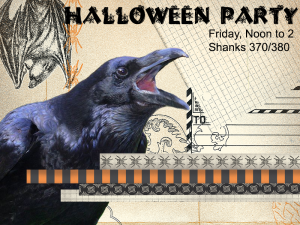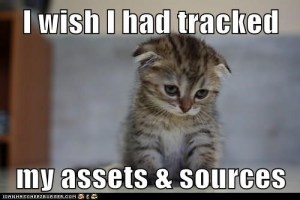This is the post for the October 29, 2014 class meeting.
 Today, we will talk about choosing your form and genre as well as gathering assets for your project
Today, we will talk about choosing your form and genre as well as gathering assets for your project
Halloween Party
Remember that the 2015 English Undergraduate Research Conference’s Halloween Party takes place on October 31, from noon to 2 PM in Shanks 370/380. During Friday’s class, I will talk about the extra credit option for people who attend.
Choosing Your Form and Genre
As you look over the remix possibilities, think about the questions you considered as you worked on Project 2 to narrow in on the best options for what you want to say:
- What modes of communication do the forms and genres enable?
- What are the affordances and constraints of the forms and genres you are considering?
- What design choices do the forms and genres support?
Hunting and Gathering
For this project, you will need to find assets, like sound clips, video clips, photographs, cartoons, and so forth to include in your project.
- To start, we’ll talk about sources and assets.
- Be sure to consult Chapter 4 of Writer/Designer, which has lots of information on gathering resources, permissions and fair use, and tracking what you find.
 Make a copy of the Project 3 Source List Template and track your sources there. See the assignment on pp. 62–63 (“A Multimodal Annotated Source List, Part 1”) for the information to include in your annotations.
Make a copy of the Project 3 Source List Template and track your sources there. See the assignment on pp. 62–63 (“A Multimodal Annotated Source List, Part 1”) for the information to include in your annotations. - Alternately, you can use your own system, like the Winnie the Pooh Sources blog entries. You might also clip info to Evernote or use a bookmarking service like Diigo.
NOTE: Finding assets is not a requirement for this week, but you will find it pays to keep track of possible assets that you find. Nothing is more frustrating than knowing that you saw something you could use and then not being able to find it again.
Choosing and Using Assets
I have posted tips for finding assets for your projects on the FAQ site. Here’s the short version:
Most importantly, know that unless you take the photo, record the audio, or film an event yourself, you need to be sure that it’s okay to use it in your writing. Remember that assets you make yourself can be simple. Take advantage of your own creativity. Anything you make, you can use freely. Consider the approaches of The Christmas Snake or Don Quixote and the Giants.
You will probably also incorporate assets that you have acquired, rather than created. Work through these FAQs for details and resources, including places to find assets that you can use freely (as long as you credit your source):
- How does copyright work with images?
- How do I choose images for my projects?
- How can I tell if an image is protected by copyright?
- Where can I find graphics that I can use in my projects?
- How do I use images in my project?
- Can I use this image if I link to the original?
Writing and Homework
-
Today: Be sure to write a blog post for today that talks about what you have accomplished since Monday and why you did what you did.
-
Friday, 10/31: We’ll talk about pitches, and you’ll send me an informal proposal for Project 3. We’ll spend some time talking about selfies as multimodal texts. Bring your cell phone so you can take selfies in class. Read the Wikipedia entry on Selfies and watch this TEDx video.
-
Monday, 11/3: Be ready to give your pitch to the class.
-
Wednesday, 11/5: We’ll go over the highlights of Chapter 5. Most of the class time will be spent working on the project.
-
Friday, 11/7: We’ll go over the highlights of Chapter 6, looking at mock-ups and storyboards. Most of the class time will be spent working on the project. I will ask you to declare the primary technologies you will use in a blog post.